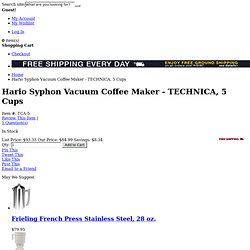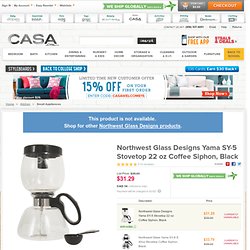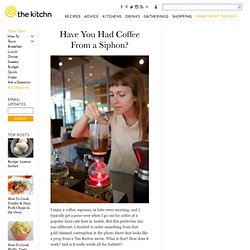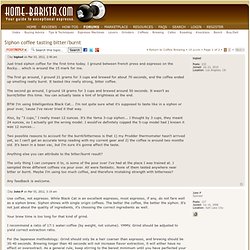Siphon Coffee
Siphon Brewing Guide. Background Siphon coffee was invented in the 1840s more or less simultaneously by a French housewife and Scottish marine engineer.

It’s been refined many times, but a few principles hold true: It produces a delicate, tea-like cup of coffee; it can be quite persnickety; and it is, for our money, one of the coolest brew methods available. Step 1 After soaking your filter in a warm water bath for at least five minutes, drop it into the bottom of your siphon’s top component, or “hopper,” and hook to the bottom of the hopper’s glass tubing. Step 2 Fill your siphon’s bottom component, or “bulb,” with 300 grams of hot water (about a 12-oz. cup’s worth). Step 3 Insert the hopper, filter and all, into the bulb. Step 4 While the water is heating, measure out between 20-25 grams of coffee and grind it just little bit finer than you would for regular drip coffee.
Step 5 Soon, the water in the bulb will begin boiling and rise up into the hopper. Step 6 Step 7. Hario Syphon Technica 20 oz Vacuum Coffee Maker: TCA-5. The Hario TCA-5 Technica may look intimidating at first blush.

But this 2-chambered coffee maker is no more difficult to use than a Bunsen burner.
Northwest Glass Yama Stovetop Coffee Siphon. The main gripes I had with that method is that the coffee seemed to fade to luke warm halfway through the cup, and my husband was forever getting the water way too hot resulting in bitter coffee.It isn't impossible to get a really good cup in the Melitta, but the the results are inconsistent for whatever reason.Enter my search for a superior cup of coffee without spending a fortune.

First I started with a grinder. After hours of research I ended up purchasing the Capresso Conical bean grinder. Going from a cheap Krups blade grinder, I am now grinding coffee like a pro. Without writing a book about all the different ways I have experimented and failed, I will say that I put the beans away after 4 or 5 attempts resulting in much too bitter coffee, and started experimenting with just water so that I could understand better when to position the top chamber (bubbles in water plus temp) as well how best to adjust my flame.
Good luck!
World Siphonist Championship. Have You Had Coffee From a Siphon?
I enjoy a coffee, espresso, or latte every morning, and I typically get a pour-over when I go out for coffee at a popular local cafe here in Austin.

But this particular day was different: I decided to order something from that gold-rimmed contraption in the photo above that looks like a prop from a Tim Burton movie. What is that? How does it work? And is it really worth all the hubbub?
Siphon Coffee: Because Single Origin Brew Wasn’t Elitist Enough. My body is nothing more than a mechanism for processing caffeine and beer.

Actually, the folks at Gawker said something much worse. But fuck those guys. If they’re so smart, why haven’t they unionized yet? Anyhoo, I love good coffee, but I’ll even drink the slime at the Shell station because, you know, addiction doesn’t give a fuck. Moreover, coffee, even bad coffee, makes you smarter and more productive. Yet there’s no reason to drink bad coffee given the wide variety of caffeine delivery systems. The best of these, both in terms of flavor and fun, is the vacuum pot, or siphon brewing system. You dump coffee (freshly ground) in the top chamber, water in the bottom, and set it on the stove. And while you can fork out for them—the Japanese system at Blue Bottle cost a cool $20K—you can also snag one on eBay for about $50. (1) Ha! I enjoy drinking things that are made out of liquid. Siphon coffee tasting bitter/burnt - Coffee Brewing.
I agree that the primary problem is the coffee: Black Cat isn't going to work well in vac pot.

Use a coffee specifically roasted for brewing. I've successfully brewed light-roasted SO espressos in my vac pot, too. Whatever you do, use fresh coffee properly rested after roast. I have the same vac pot you do. I grind for it on my Baratza Vario very slightly finer than I do for drip (one notch on the macro lever.) 1. 2. 3. 4.






